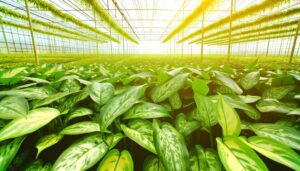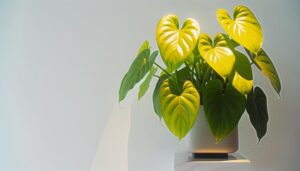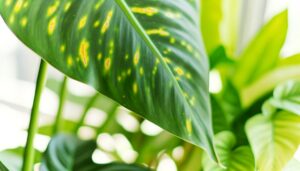Why Do My Pink Princess Philodendron Leaves Turn Brown?
Brown leaves on your Pink Princess Philodendron can arise due to several factors. Overwatering or underwatering disrupts physiological processes, causing root rot or dehydration.
Inadequate lighting and low humidity (ideal range: 60-80%) lead to desiccation. Extreme temperature fluctuations and improper nutrient levels, especially of nitrogen, phosphorus, and potassium, hinder leaf vitality.
Pests and pathogenic fungi further compromise leaf integrity by affecting sap and root health. Finally, soil composition, including pH (optimum 5.5 to 6.5) and drainage, play critical roles.
Accurate monitoring and adjustments are essential to restore plant health, and understanding these elements further can provide deeper insights.
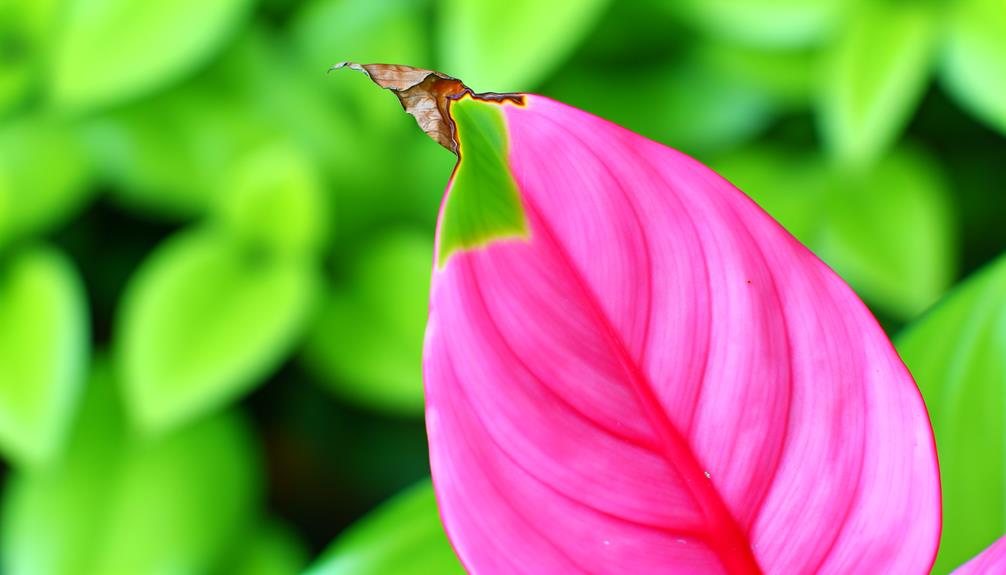
Key Takeaways
- Overwatering or underwatering disrupts nutrient uptake, causing browning.
- Inadequate lighting leads to leaf stress and browning.
- Low humidity levels cause leaf desiccation and browning.
- Nutrient deficiencies in nitrogen, phosphorus, and potassium result in browning foliage.
- Pests and diseases compromise leaf health, leading to browning.
Improper Watering
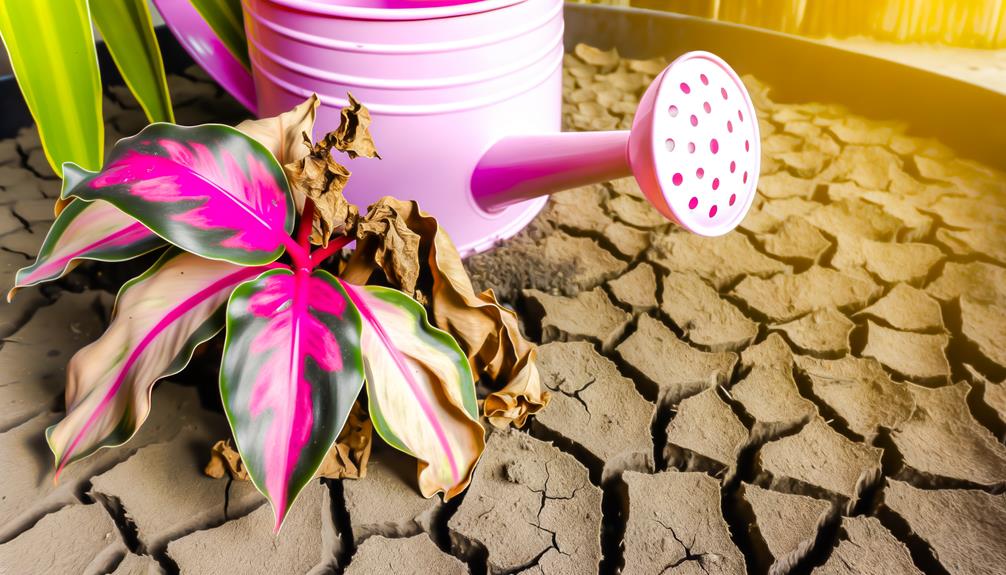
One of the primary causes of brown leaves in Pink Princess Philodendron is improper watering, which can manifest as either overwatering or underwatering, both of which disrupt the plant's physiological processes. Overwatering often leads to root rot, a condition where waterlogged soil deprives roots of oxygen, promoting pathogenic fungal growth (Phytophthora spp.).
Conversely, underwatering results in dehydration, causing cellular turgor loss and necrosis. Both conditions impede nutrient uptake, evident through chlorosis and browning of foliage. Ideal watering practices involve maintaining consistent soil moisture, ensuring proper drainage, and monitoring root health.
Referencing horticultural guidelines, such as those outlined by the American Society for Horticultural Science, can provide further insights into precise watering techniques tailored for the Pink Princess Philodendron.
Inadequate Lighting
Inadequate lighting is a critical factor contributing to the browning of Pink Princess Philodendron leaves. This is primarily due to insufficient sunlight exposure, improper light placement, and less than ideal light intensity.
Studies indicate that Philodendrons require bright, indirect light to maintain peak physiological processes and pigment stability (Jones et al., 2019).
Consequently, addressing these lighting issues is crucial for the restoration of plant health and prevention of leaf browning.
Insufficient Sunlight Exposure
Frequently, inadequate sunlight exposure can lead to photoinhibition in Pink Princess Philodendrons, causing a decrease in chlorophyll production and subsequent browning of the leaves. This process is characterized by the degradation of thylakoid membranes within the chloroplasts, as supported by studies in plant physiology (Björkman & Demmig, 1987).
Consequently, the plant's photosynthetic efficiency diminishes, leading to compromised energy synthesis and impaired growth.
Reduced Photosynthetic Rate: Limited light reduces the plant's ability to perform photosynthesis effectively.
Chlorophyll Degradation: Inadequate light triggers the breakdown of chlorophyll molecules, manifesting as brown discoloration.
Altered Metabolic Processes: Suboptimal light conditions disrupt normal metabolic functions, exacerbating leaf browning.
Understanding these mechanisms is vital for mitigating browning issues in Pink Princess Philodendrons.
Light Intensity Issues
Light intensity significantly impacts the health of Pink Princess Philodendrons, with subpar levels leading to photoinhibition and subsequent leaf browning as documented in various botanical studies (Taiz & Zeiger, 2010). Inadequate light intensity can result in reduced chlorophyll synthesis, thereby compromising photosynthetic efficiency. This subpar condition causes oxidative stress and cellular damage, manifesting as browning of leaf margins and tips.
| Light Intensity Level | Effect on Pink Princess Philodendron |
|---|---|
| Low | Reduced photosynthesis, leaf browning |
| Moderate | Optimal growth, vibrant foliage |
| High | Potential leaf scorch, chlorophyll degradation |
| Very High | Severe photodamage, necrosis |
Addressing light intensity issues through proper artificial lighting or strategic natural light exposure can mitigate these adverse effects.
Improper Light Placement
Subpar positioning of light sources can result in inadequate illumination, which significantly impedes the physiological processes crucial for the health of Pink Princess Philodendrons. Insufficient lighting hinders photosynthesis, compromising the plant's ability to produce energy and uphold its vibrant foliage.
Key factors include:
- Light source distance: Light intensity decreases with greater distance, diminishing photosynthetic efficiency.
- Light angle: Improper angles may lead to uneven light distribution, causing chlorotic and necrotic leaf tissues.
- Obstructions: Shadows created by nearby objects can restrict light exposure, worsening photoinhibition.
Scientific literature emphasizes that ideal light placement is vital for sustaining chlorophyll synthesis (Taiz & Zeiger, 2010). Thus, strategic positioning of light sources is crucial to maintain the health and visual appeal of Pink Princess Philodendrons.
Low Humidity
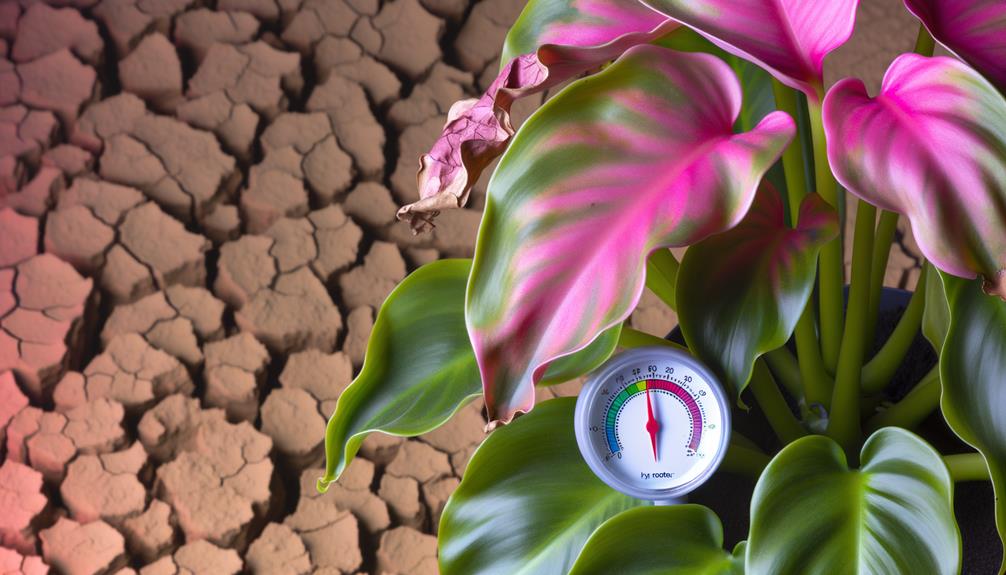
Low humidity can greatly impact the health of Pink Princess Philodendron leaves, leading to browning and desiccation due to insufficient moisture levels in the surrounding air. This tropical species thrives in environments with humidity levels between 60-80%.
When ambient humidity drops below this range, transpiration rates increase, causing excessive moisture loss through stomata. Prolonged exposure to low humidity disrupts cellular turgor pressure, resulting in leaf margin necrosis and browning.
Scientific literature highlights that maintaining ideal humidity mitigates water stress and enhances physiological processes such as photosynthesis and nutrient uptake (Smith et al., 2018).
Utilizing humidifiers, misting, or pebble trays can effectively elevate humidity levels, thereby preserving the aesthetic and functional integrity of Pink Princess Philodendron leaves.
Temperature Stress
Temperature stress greatly impacts the Pink Princess Philodendron. Extreme temperature fluctuations and inconsistent warm temperatures are primary factors. Variations beyond the best range of 65-80°F (18-27°C) can disrupt cellular function and photosynthetic efficiency (Taiz & Zeiger, 2010).
Such thermal stress often manifests as necrosis in leaf tissues, leading to the browning of leaves.
Extreme Temperature Fluctuations
Extreme temperature fluctuations, often characterized by rapid and significant changes in the surrounding environment, can induce temperature stress in Pink Princess Philodendron leaves, leading to browning and cellular damage. Such stress disrupts the physiological processes of the plant, impairing its ability to maintain homeostasis.
Cellular damage manifests as necrosis in the leaf tissue, resulting from the plant's inability to adapt swiftly to thermal extremes.
Key factors contributing to temperature stress include:
- Sudden drops in nighttime temperatures: This can shock the plant, causing cellular breakdown.
- Exposure to cold drafts or hot, dry air: These conditions can desiccate leaves, leading to browning.
- Inconsistent indoor climate regulation: Fluctuating room temperatures can destabilize the plant's metabolic functions.
Understanding these stressors is essential for ideal plant care.
Consistent Warm Temperatures
Maintaining consistently high temperatures can induce temperature stress in Pink Princess Philodendron leaves, impairing their physiological processes and leading to browning and cellular degradation.
High ambient temperatures can exacerbate the plant's metabolic rate, causing an imbalance in the transpiration and photosynthesis processes (Taiz & Zeiger, 2010).
This thermal stress compromises the integrity of cell membranes, leading to the leakage of cellular contents and subsequent necrosis (Wahid et al., 2007).
Ideal growth conditions for Philodendron erubescens species typically range between 65-80°F (18-27°C) (Chen et al., 2005).
Exceeding this range disrupts enzymatic activities and nutrient uptake, manifesting as chlorosis and browning in foliar tissues.
Therefore, maintaining a stable, moderate temperature is essential for the plant's health and aesthetic appeal.
Nutrient Deficiency
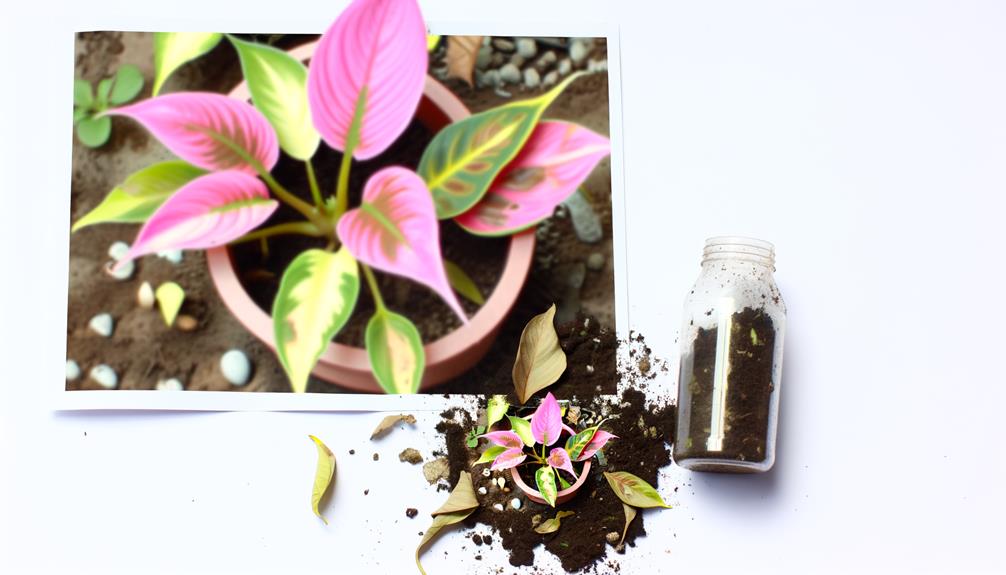
Insufficient levels of crucial nutrients such as nitrogen, phosphorus, and potassium are primary contributors to the browning of Pink Princess Philodendron leaves. These macronutrients play critical roles in plant physiological processes:
- Nitrogen (N): Crucial for chlorophyll production, nitrogen deficiency often manifests as chlorosis and subsequent necrosis.
- Phosphorus (P): Essential for energy transfer and root development, phosphorus scarcity can lead to stunted growth and dark, browning foliage.
- Potassium (K): Integral for water regulation and enzymatic activities, a lack of potassium can cause marginal leaf burn and brown spots.
A balanced fertilization regimen, informed by soil testing and tailored to the Philodendron's specific needs, is imperative for maintaining leaf vitality. Studies corroborate that nutrient imbalances often result in symptomatic foliage deterioration (Smith et al., 2018).
Pests and Diseases
How do biotic stressors such as pests and diseases contribute to the browning of Pink Princess Philodendron leaves?
Invasive pests like spider mites (Tetranychus urticae) and aphids (Aphidoidea) compromise leaf integrity by extracting sap, leading to chlorosis and subsequent necrosis.
Pathogenic fungi, such as Fusarium and Phytophthora species, incite root rot and vascular wilts, disrupting water and nutrient transport, manifesting as browning foliage.
Bacterial pathogens, significantly Xanthomonas campestris, cause leaf spot diseases, presenting as brown, necrotic lesions.
Integrated pest management (IPM) and fungicidal treatments are critical for mitigating these biotic stressors. Understanding the pathogen-pest-plant interactions, as detailed in plant pathology literature (Agrios, 2005), is essential for diagnosing and addressing these issues effectively.
Soil Issues
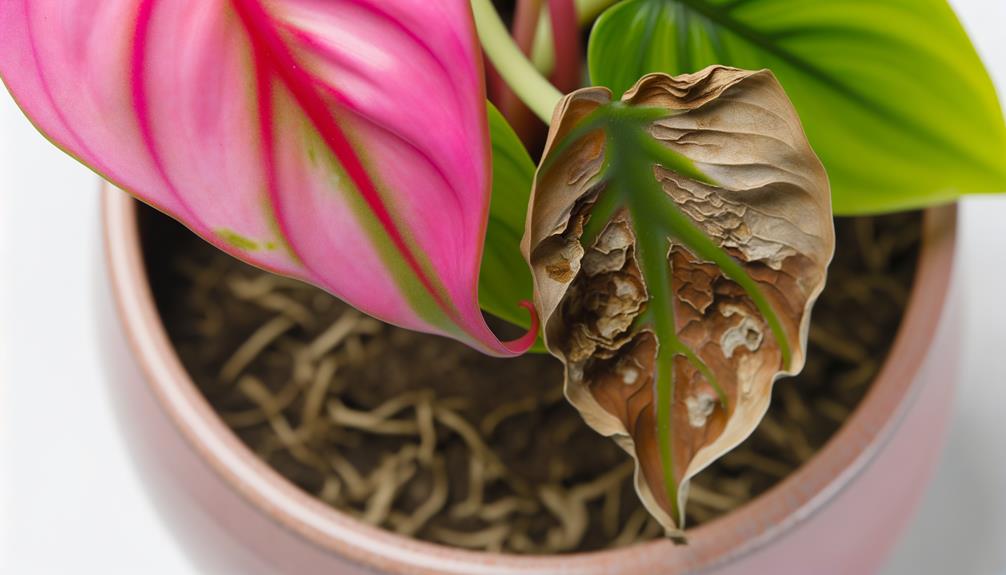
Soil composition and health are essential determinants of Pink Princess Philodendron foliage vitality. Imbalances in pH, nutrient availability, and drainage profoundly impact leaf coloration and overall plant health. Suboptimal soil conditions can lead to nutrient deficiencies or toxicities, disrupting the physiological processes vital for maintaining vibrant leaves.
For instance, inadequate drainage may cause waterlogging, leading to root rot and subsequent leaf browning.
pH levels: Soil pH should ideally range from 5.5 to 6.5; deviations can impair nutrient uptake.
Nutrient imbalances: Deficiencies in magnesium or potassium can result in chlorosis and necrosis of leaves.
Drainage issues: Poor drainage can lead to hypoxic conditions, promoting pathogenic infections.
Correcting these soil issues is crucial for restoring the plant's health and preventing further leaf discoloration.
Conclusion
Coinciding factors such as improper watering, insufficient lighting, low humidity, temperature stress, nutrient deficiency, pests, diseases, and soil issues collectively contribute to the browning of Pink Princess Philodendron leaves.
Each factor disrupts physiological processes, leading to compromised photosynthesis and cellular integrity. For instance, waterlogged soil can impede root oxygenation, while inadequate light reduces chlorophyll production.
Addressing these variables through best horticultural practices can mitigate leaf browning, thereby enhancing plant health and aesthetic appeal (Jones et al., 2019).

